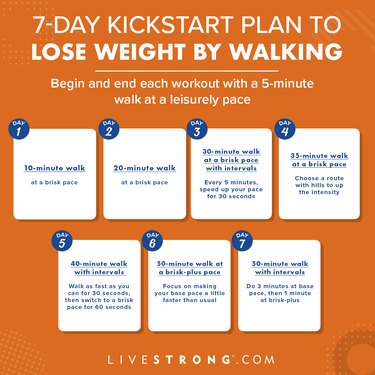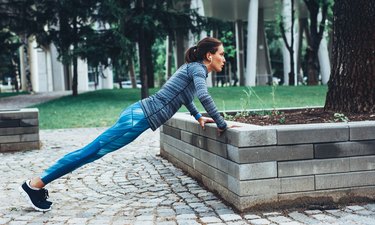
When you think about exercises that help you drop pounds, you may think of vigorous cardio like running or spinning. But walking can be an excellent weight-loss workout if you do it consistently and keep your pace brisk.
Weight loss happens when you burn more calories than you take in. Any type of physical activity can help you make that happen, but there are plenty of reasons why walking works so well.
Video of the Day
Video of the Day
"It's the simplest form of aerobic exercise, making it a great choice for a kickstart plan to lose weight," Cathy Richards, an ACSM-certified exercise physiologist, tells LIVESTRONG.com. "You can walk on a treadmill or outdoors, no financial investment is necessary and no special equipment is required other than a pair of walking shoes."
If you're just getting started toward your weight-loss goal, a simple walking plan can help you burn more calories every day while boosting your fitness. Over time, you can add in new moves to increase the intensity and ramp up the calorie burn even more.
This seven-day plan, created by Richards, helps you do just that.
Designed to torch 200 to 400 calories per day, it can kick your weight loss into gear by helping you lose 1 to 3 pounds in a week, assuming you also make some changes to your diet. (Though it might take four to six weeks for more noticeable results.) Here's how to get started.
Related Reading
Your Walking Plan to Lose Weight

Richards' plan starts off with just 20 minute of brisk walking. You'll build up to walking a little farther each day, and as you get fitter, you can add on extra moves to stay challenged and boost your burn.
Remember to keep up a brisk pace as you walk: "A moderate, somewhat hard pace is the goal," Richards says. "If you can't talk while you're walking, you're working too hard. If you can sing or talk at great length, you're probably not working hard enough."
Day 1: 20-Minute Walk
- 5-minute warm-up: Walk at a leisurely pace
- 10-minute walk at a brisk pace
- 5-minute cool-down: Walk at a leisurely pace
Day 2: 30-Minute Walk
- 5-minute warm-up: Walk at a leisurely pace
- 20-minute walk at a brisk pace
- 5-minute cool-down: Walk at a leisurely pace
Day 3: 40-Minute Walk
- 5-minute warm-up: Walk at a leisurely pace
- 30-minute walk at a brisk pace with intervals: Every 5 minutes, speed up your pace for 30 seconds, then come back to your base pace for 5 more minutes
- 5-minute cool-down: Walk at a leisurely pace
Day 4: 45-Minute Walk
- 5-minute warm-up: Walk at a leisurely pace
- 35-minute walk at a brisk pace: Choose a route that has hills today to up your intensity and overall calorie burn
- 5-minute cool-down: Walk at a leisurely pace
Day 5: 50-Minute Walk
- 5-minute warm-up: Walk at a leisurely pace
- 40-minute walk at a brisk pace: It's another interval day except this time, you'll interval high and low much more often. Walk as fast as you can for 30 seconds and switch back to your baseline brisk pace for 60 seconds. Try to sustain this for as long as you can.
- 5-minute cool-down: Walk at a leisurely pace
Day 6: 60-Minute Walk
- 5-minute warm-up: Walk at a leisurely pace
- 50-minute walk at a brisk-plus pace: Focus on making your base pace a little faster than usual. (Listening to fast music can help!)
- 5-minute cool-down: Walk at a leisurely pace
Day 7: 60-Minute Walk
- 5-minute warm-up: Walk at a leisurely pace
- 50-minute walk with intervals: Do 3 minutes at base pace then 1 minute at brisk-plus. Keep this 4-minute cycle going for as much of the 50-minutes as you can.
- 5-minute cool-down: Walk at a leisurely pace

Boost the Intensity

Over time, as your fitness improves, you can shake things up and make them even more challenging by adding a few power moves into your walk. Try things like:
Push-ups: Start face down on your hands and knees or hands and feet. Be sure to keep your body rigid as you go down and up and focus on bending your elbows fully. If full push-ups are too challenging, do a modified push-up on your knees or by leaning against a wall.
Stationary lunges: Stand in a wide lunge position with your feet parallel. Keep your front foot planted and your weight on the ball of your back foot. Slowly lower your body down until your back knee almost touches the ground while letting your front knee bend to 90 degrees. Keep your front knee straight above your front foot. Push straight up through the heel of your front foot and the ball of your back foot until you are up again. (Do not push forward, only push up.) Repeat the movement up to 10 or 20 times on one side before switching to the opposite foot in front.
Planks: Start on the floor lying on your stomach. Come up on your toes and forearms, keeping your body completely straight (don't let your hips sag down or pike up). If you find that this position is too intense, you can do the modified version on your toes and hands. The goal is to stay in this position for as long as possible. At first, this could be just 10 seconds, but try to build up to 60 seconds or more.
Related Reading
Don’t Forget About Your Diet

It's hard to lose weight just by exercising alone. "It's very easy to eat more calories than you burn in a day even if you are working out every day," Richards says. "If that happens, you could easily sabotage your weight-loss efforts or even gain weight."
You need to burn about 3,500 calories to lose a pound of fat. To lose that pound in a week, you'll want to eat about 500 fewer calories per day, according to the Mayo Clinic. You can make that happen by:
- Eating smaller portions: Try serving yourself a little bit less at each meal. Using a smaller plate or bowl may make it feel like you're still eating a generous amount.
- Swapping high-cal foods for lower-cal ones: Use mustard on your sandwich instead of mayo, make an omelet with veggies instead of cheese or snack on an apple instead of a muffin.
- Having high-calorie treats less often: Save the cookies or ice cream for once or twice a week instead of every day.
Over time, these small dietary changes paired with daily exercise will add up. You might see progress on the scale in as little as a week and start to notice a difference in the mirror within a month or so.
Related Reading
Was this article helpful?
150 Characters Max
0/150
Thank you for sharing!
Thank you for your feedback!